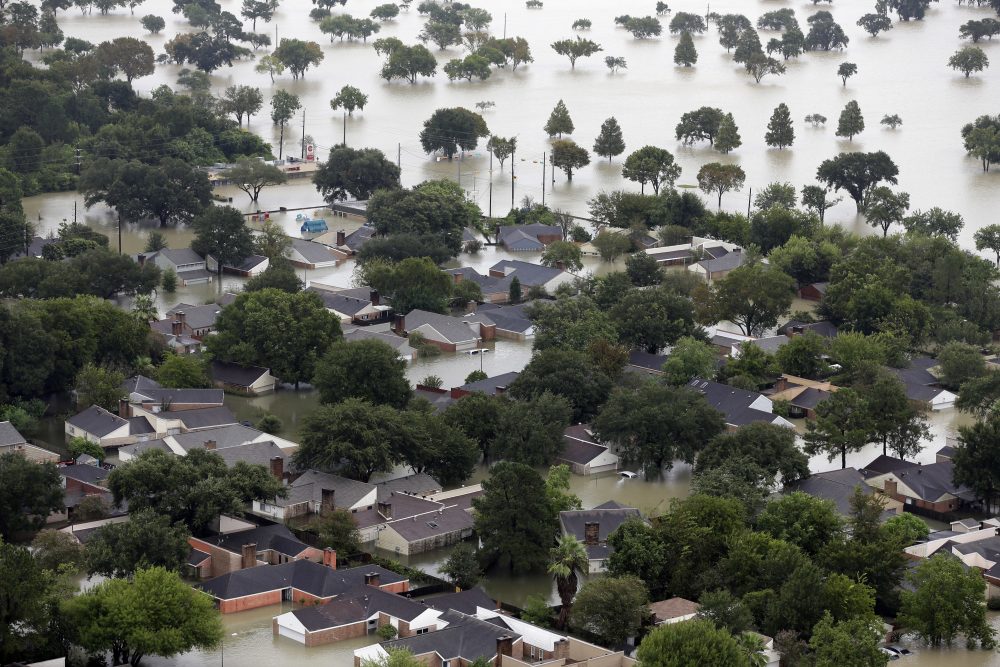Advertisement
Cape Cod Coast Guard Members Deployed To Houston As Part Of Rescue Operations
Resume
President Trump was in Texas on Tuesday to get the latest information on recovery efforts from Hurricane Harvey. Harvey was downgraded to a tropical storm after making landfall on Friday.
Over 49 inches had fallen in Houston as of 10 a.m. Tuesday. This tops the previous record of 48 inches during 1978's Tropical Storm Amelia. Texas Gov. Greg Abbot said he's glad the president is in Texas to see rescue and recovery efforts.
"Everyone in the state of Texas is focused first on saving every life that we can," said Gov. Abbot. "Then we want to help with the evacuation and transition process, and in typical Texas fashion, we will rebuild, and make it better than ever."
The storm is currently over the Gulf of Mexico, and is on track to make its way to Louisiana by Wednesday afternoon.
Several deaths have been reported, but a final number won't be released until autopsies are finished.
Guest
Lt. Commander Simon Greene, deployed from Joint Base Cape Cod. He and his fellow coast guard members are conducting rescue operations in Houston.
Interview Highlights
On what the scene in Houston is like
We got here early Monday morning and immediately started going to work doing rescues. A fair portion of the city was already inundated. We went out looking for folks on rooftops, waving flags and shining their lights. And we immediately started hoisting, and taking them to the closest triage places we could find. Right now, more of the city has become inundated in the past three days that we have been here. And so we have planned Coast Guard assets around the clock going out and doing hoisting. About 30 percent of the Coast Guard air assets from all over the country are here in Houston right now.
On the rescue process when people are found on rooftops
So normally our crew is four people. There are two pilots, a flight mechanic — they control the hoist up and down — and then we have our rescue swimmer. Here, because of the sheer quantity of survivors on the ground, I've been taking two swimmers with me. So we put both down together. They go down. There may be a group of one, two 10. Yesterday we had 30, 40 folks coming out of houses and congregating underneath the helicopter. So one of my swimmers will triage. We hoisted a ton of newborn babies and elderly. My swimmer was putting folks who are disabled on his back and carrying them out to the basket. He tries to triage, and take the ones that need care the most. We hoist them until our cabin is full. Seven to 14 or 15 was our max yesterday. We go and try to find a place that we can land to get them off at least to dry land. Then there are other assets that can come and land that aren't hoist-capable to move them to shelters, etc. And then we're immediately right back on scene.
On the number of people they have rescued
The first day we had about 25. We're still getting our feet wet, for lack of a better term. And then yesterday we hoisted, I think all told it was somewhere in the low 80s. About a hundred all told.
And we're just one of multiple — high teens to 20s — Coast Guard air assets that are here in the theater. One crew will go out in the morning. They'll fly until they hit their exhaustion limits and then another crew will go out and they'll fly in the afternoon and evening. So it's basically continuous. Then all night they're getting repaired, refueled, whatever the planes require to go back out in the morning.
On the challenges of conducting rescues in the midst of the storm
The visibility here has been terrible. It's just been absolute torrential pouring since we got here, and it hasn't let up. So navigating around the city, specially for all of us that aren't familiar with it, has been pretty dangerous. We've literally just been following roads because there aren't antennas in the middle of a road, until we need to jump off of it and go to a neighborhood. So we've been flying anywhere from 80 feet off the deck to 250 feet off the deck to navigate. Because of that, we're a little loath to fly at night. The danger and the chances of striking wires rises exponentially. And it's also really dangerous to put a swimmer down into a dark environment. He doesn't know what's going on, or we don't know where the cable is if it gets wrapped around something. So that risk outweighs even the high gain of potentially saving a life.
Just to get out and get around the city in these conditions is not optimal but it's definitely something that we can handle. That's why flight school is two years, and we train constantly for this sort of thing. It's just another day I guess for us.
This segment aired on August 29, 2017.

